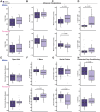This is a preprint.
Loss of DOT1L disrupts neuronal transcription, behavior, and leads to a neurodevelopmental disorder
- PMID: 39574879
- PMCID: PMC11581099
- DOI: 10.1101/2024.10.31.24314716
Loss of DOT1L disrupts neuronal transcription, behavior, and leads to a neurodevelopmental disorder
Update in
-
Loss of DOT1L disrupts neuronal transcription and leads to a neurodevelopmental disorder.Brain. 2025 Jun 11:awaf212. doi: 10.1093/brain/awaf212. Online ahead of print. Brain. 2025. PMID: 40494548
Abstract
Individuals with monoallelic gain-of-function variants in the histone lysine methyltransferase DOT1L display global developmental delay and varying congenital anomalies. However, the impact of monoallelic loss of DOT1L remains unclear. Here, we sought to define the effects of partial DOT1L loss by applying bulk and single-nucleus RNA-sequencing, ChIP-sequencing, imaging, multielectrode array recordings, and behavioral analysis of zebrafish and multiple mouse models. We present a cohort of 16 individuals (12 females, 4 males) with neurodevelopmental disorders and monoallelic DOT1L variants, including a frameshift deletion, an in-frame deletion, a nonsense, and missense variants clustered in the catalytic domain. We demonstrate that specific variants cause loss of methyltransferase activity. In primary cortical neurons, Dot1l knockdown disrupts transcription of synaptic genes, neuron branching, expression of a synaptic protein, and neuronal activity. Further in the cortex of heterozygous Dot1l mice, Dot1l loss causes sex-specific transcriptional responses and H3K79me2 depletion, including within down-regulated genes. Lastly using both zebrafish and mouse models, we found behavioral disruptions that include developmental deficits and sex-specific social behavioral changes. Overall, we define how DOT1L loss leads to neurological dysfunction by demonstrating that partial Dot1l loss impacts neuronal transcription, neuron morphology, and behavior across multiple models and systems.
Keywords: DOT1L; loss-of-function; neurodevelopmental disorders.
Conflict of interest statement
Competing interests KV has received honoraria as an advisory board member, travel expenses and speaker fees from Biogen, Santhera, Orchard, ITF and Novartis, outside the submitted work. JLM is an employee of and may own stock in GeneDx, LLC. All other authors declare they have no competing interests.
Figures








References
-
- Megan Cleaton MA, Kirby A. Why Do We Find it so Hard to Calculate the Burden of Neurodevelopmental Disorders. J Child Dev Disord. 2018;04(03). doi: 10.4172/2472-1786.100073 - DOI
-
- Francés L, Quintero J, Fernández A, et al. Current state of knowledge on the prevalence of neurodevelopmental disorders in childhood according to the DSM-5: a systematic review in accordance with the PRISMA criteria. Child Adolesc Psychiatry Ment Health. 2022;16:27. doi: 10.1186/s13034-022-00462-1 - DOI - PMC - PubMed
-
- Axelrad Daniel, Adams Kristen, Chowdhury Farah, et al. America’s Children and the Environment, Third Edition.
Publication types
Grants and funding
LinkOut - more resources
Full Text Sources
